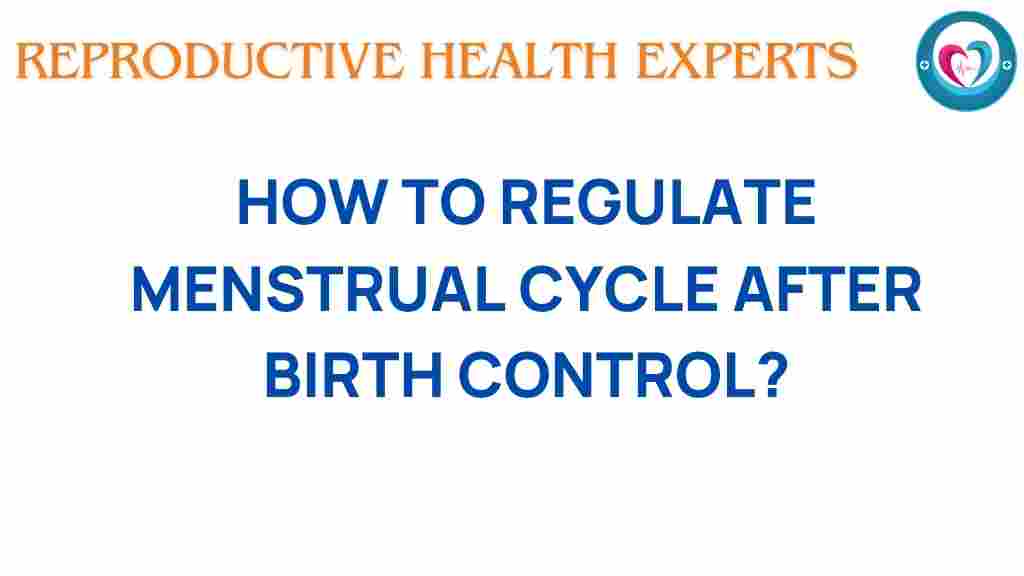Unlocking the Secrets: Regulating Your Menstrual Cycle After Birth Control
Many women rely on birth control to manage their reproductive health, but what happens when it’s time to transition off? The journey to regulating your menstrual cycle after birth control can feel daunting. Understanding hormone balance, cycle regulation, and the nuances of post-contraceptive care is crucial for your overall women’s health, fertility, and menstruation experience. This article aims to provide you with a comprehensive guide to help you navigate this important phase of your life, offering menstruation tips that can ease the process.
The Impact of Birth Control on Your Menstrual Cycle
Birth control methods, including pills, patches, and hormonal implants, are designed to suppress ovulation and regulate your menstrual cycle. However, once you stop using them, your body may take time to readjust. Understanding this transition is key to managing your reproductive health effectively.
- Hormone Disruption: Birth control alters your natural hormone levels, which can lead to irregular cycles as your body attempts to regain its balance.
- Delayed Return to Normalcy: After discontinuation, it’s common for some women to experience delays in their menstrual cycle.
- Symptoms of Hormonal Imbalance: Mood swings, cramps, and other symptoms may arise as your body recalibrates.
Steps to Regulate Your Menstrual Cycle After Birth Control
Regulating your menstrual cycle after birth control involves a series of steps focused on restoring your hormone balance and promoting cycle regulation. Here’s how to get started:
1. Understanding Your Cycle
Before making any changes, it’s essential to understand your natural menstrual cycle. Track your periods using a calendar or a smartphone app. This will help you identify patterns and irregularities.
2. Maintain a Healthy Lifestyle
Adopting a healthy lifestyle can significantly impact your cycle regulation. Consider the following:
- Balanced Diet: Incorporate a variety of fruits, vegetables, whole grains, lean proteins, and healthy fats into your meals.
- Regular Exercise: Aim for at least 150 minutes of moderate aerobic activity each week to promote blood circulation and hormone balance.
- Hydration: Drink plenty of water to support overall health and hormonal function.
3. Manage Stress Levels
Stress can have a profound effect on your menstrual cycle. Implement stress-reduction techniques such as:
- Meditation and mindfulness practices
- Yoga and breathing exercises
- Adequate sleep and relaxation
4. Consider Natural Supplements
Some natural supplements can help restore hormone balance and regulate your menstrual cycle:
- Vitex (Chaste Tree Berry): Traditionally used to promote hormonal balance.
- Omega-3 Fatty Acids: Found in fish oil, they can help reduce inflammation and support hormonal health.
- B Vitamins: Essential for energy and hormone synthesis.
Always consult with a healthcare provider before starting any supplement regimen.
5. Monitor Your Symptoms
Keep a record of any symptoms you experience while your body readjusts. This can include:
- Changes in cycle length
- Menstrual flow intensity
- Physical and emotional symptoms
Monitoring your symptoms can help you and your healthcare provider make informed decisions about your reproductive health.
6. Consult with a Healthcare Provider
If you experience significant irregularities or discomfort, it’s important to speak with a healthcare provider. They can offer personalized advice and may recommend further tests to rule out underlying conditions.
Troubleshooting Common Issues
Many women encounter challenges while trying to regulate their menstrual cycle after birth control. Here are some common issues and tips to troubleshoot them:
Irregular Periods
If your periods are irregular or delayed:
- Continue tracking your cycle, as it may take several months to normalize.
- Consider lifestyle changes, such as improving diet and exercise.
- Consult with a doctor if irregularities persist for more than six months.
Heavy or Prolonged Bleeding
Heavy bleeding can be concerning. If you experience this:
- Keep a record of your flow to discuss with your healthcare provider.
- Stay hydrated and maintain a balanced diet, which may help.
- Seek medical advice if you soak through a pad or tampon every hour for several hours.
Severe Cramps
Severe menstrual cramps can be debilitating. To alleviate them:
- Try over-the-counter pain relief medications.
- Use heat pads or take warm baths to soothe cramps.
- Practice relaxation techniques including yoga or meditation.
Conclusion
Regulating your menstrual cycle after birth control is a journey that requires patience and self-care. By understanding your body, maintaining a healthy lifestyle, managing stress, and consulting with healthcare providers, you can take effective steps towards achieving hormone balance and cycle regulation. Women’s health and fertility are interconnected, and taking charge of your reproductive health is empowering.
For more information on post-contraceptive care and reproductive health, consider visiting Women’s Health Network. Remember, each woman’s experience is unique, so listen to your body and adjust your approach as needed.
Implement these menstruation tips into your routine, and you’ll be well on your way to a healthier, more balanced menstrual cycle.
This article is in the category Menstruation and created by ReproductiveHealthExperts Team
